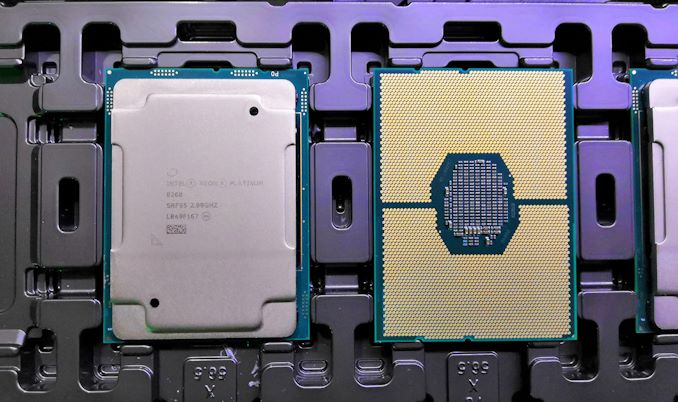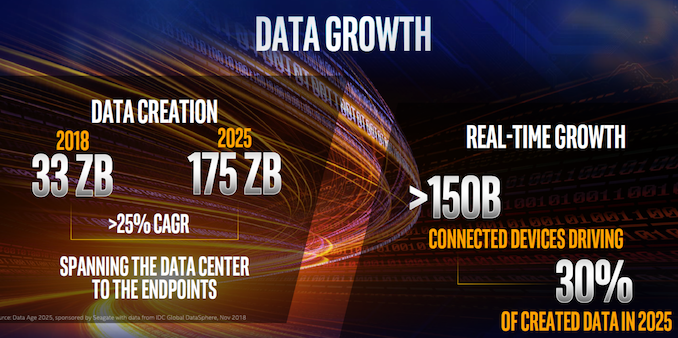Intel's Xeon Cascade Lake vs. NVIDIA Turing: An Analysis in AI
by Johan De Gelas on July 29, 2019 8:30 AM EST
It seems like the new motto for Silicon Valley for the last few years has been “Data is the new oil,” and for good reason. The number of companies employing machine learning-based AI technologies has exploded, and even a few years after all of this has kicked off in earnest, those numbers continue to grow. This form of AI is no longer just an academic thesis or curious research project, but instead machine learning has become an important part of the enterprise market, and the impact on enterprise hardware – both purchasing and development – would be difficult to overstate. This is the era of AI.
At first sight, the hardware choices for these kinds of applications seem simple: Intel Xeon CPUs for storing and preprocessing data, NVIDIA GPUs for (almost) everything AI. And indeed, this has largely been case for the last few years now. However, NVIDIA’s competitors have not been standing idly by the entire time – and that especially goes for Intel, whose enterprise market share all of this ultimately threatens. With everything from dedicated low-power inference processors to purpose-optimized Xeons, Intel is taking aim at every level of the AI market. The net result is that between all of these competitors, we’re seeing AI tackled from many different directions, and the hardware battle for AI era is insanely interesting in our humble opinion.
Today we’re taking a look at what’s perhaps the heart of Intel’s hardware in the AI space, Intel’s second-generation Xeon Scalable processors, better known as "Cascade Lake". Introduced a bit earlier this year, these new processors are still based on the same core Skylake architecture as the first-generation products, but incorporate a number of new instructions to speed up AI performance.
And as far as new technology goes, this is certainly the most interesting aspect of Cascade Lake. While we could talk about the three to six percent general CPU performance improvement, the 56 cores of Intel’s most expensive processor ever, and the "world record benchmarks," these small improvements are close to irrelevant for the near and mid-term future of the IT world. Just look at the very first slide of the Intel press & analyst briefing.
Internet of things, data engineering, and AI. That is where a large part of the growth, the innovation, and the future of IT will be. And this is where Intel wants to be.
Right now, NVIDIA has a virtual monopoly on the “sexiest” part of this market, which is deep learning and “massively parallel HPC” software. Thanks to a confluence of factors on the hardware and software sides, most of this software is run on NVIDIA GPUs and clusters. So to the general public, it looks likes NVIDIA owns the “AI market”, a picture that is not inaccurate, but also not complete. There’s a lot more to the AI market than just neural network inferencing, and in particular, everything that has to happen to feed the AI model with data gets very little attention. As a result, it’s neural networks and Terminator robots that get all the headlines, even though they’re just part of the of the picture. In reality, the processing web for AI applications is much more like the picture below.
In short, actual machine learning code execution is only a very small part of the software tools necessary to build and AI Application.
Before you can even start, you have to ingest data, decompress, filter, reorder, map, and shuffle it around. Once everything is sorted and shuffled, you have to aggregate the data. As ML algorithms need large amounts of data to produce good predictions, that can be very processing memory intensive. Why? Let us delve a little deeper.












56 Comments
View All Comments
tipoo - Monday, July 29, 2019 - link
Fyi, when on page 2 and clicking "convolutional, etc" for page 3, it brings me back to the homepageRyan Smith - Monday, July 29, 2019 - link
Fixed. Sorry about that.Eris_Floralia - Monday, July 29, 2019 - link
Johan's new piece in 14 months! Looking forward to your Rome review :)JohanAnandtech - Monday, July 29, 2019 - link
Just when you think nobody noticed you were gone. Great to come home again. :-)Eris_Floralia - Tuesday, July 30, 2019 - link
Your coverage on server processors are great!Can still well remember Nehalem, Barcelona, and especially Bulldozer aftermath articles
djayjp - Monday, July 29, 2019 - link
Not having a Tesla for such an article seems like a glaring omission.warreo - Monday, July 29, 2019 - link
Doubt Nvidia is sourcing AT these cards, so it's likely an issue of cost and availability. Titan is much cheaper than a Tesla, and I'm not even sure you can get V100's unless you're an enterprise customer ordering some (presumably large) minimum quantity.olafgarten - Monday, July 29, 2019 - link
It is available https://www.scan.co.uk/products/32gb-pny-nvidia-te...abufrejoval - Tuesday, July 30, 2019 - link
Those bottlenecks are over now and P100, V100 can be bought pretty freely, as well as RTX6000/8000 (Turings). Actually the "T100" is still missing and the closest siblings (RTX 6000/8000) might never get certified for rackmount servers, because they have active fans while the P100/V100 are designed to be cooled by server fans. I operate a handful of each and getting budget is typically the bigger hurdle than purchasing.SSNSeawolf - Monday, July 29, 2019 - link
I've been trying to find more information on Cascade Lake's AI/VNNI performance, but came up dry. Thanks, Johan. Eagerly putting this aside for my lunch reading today.